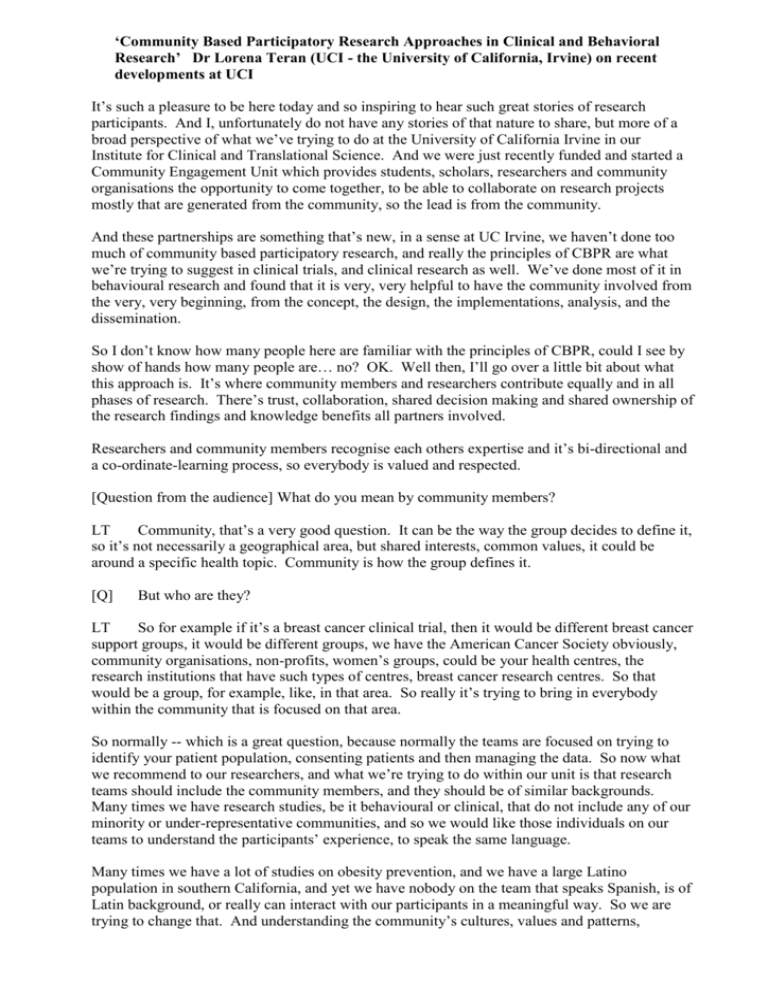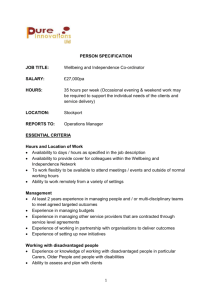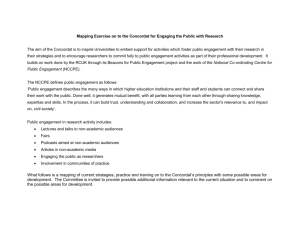`Community Based Participatory Research Approaches in Clinical and
advertisement

‘Community Based Participatory Research Approaches in Clinical and Behavioral Research’ Dr Lorena Teran (UCI - the University of California, Irvine) on recent developments at UCI It’s such a pleasure to be here today and so inspiring to hear such great stories of research participants. And I, unfortunately do not have any stories of that nature to share, but more of a broad perspective of what we’ve trying to do at the University of California Irvine in our Institute for Clinical and Translational Science. And we were just recently funded and started a Community Engagement Unit which provides students, scholars, researchers and community organisations the opportunity to come together, to be able to collaborate on research projects mostly that are generated from the community, so the lead is from the community. And these partnerships are something that’s new, in a sense at UC Irvine, we haven’t done too much of community based participatory research, and really the principles of CBPR are what we’re trying to suggest in clinical trials, and clinical research as well. We’ve done most of it in behavioural research and found that it is very, very helpful to have the community involved from the very, very beginning, from the concept, the design, the implementations, analysis, and the dissemination. So I don’t know how many people here are familiar with the principles of CBPR, could I see by show of hands how many people are… no? OK. Well then, I’ll go over a little bit about what this approach is. It’s where community members and researchers contribute equally and in all phases of research. There’s trust, collaboration, shared decision making and shared ownership of the research findings and knowledge benefits all partners involved. Researchers and community members recognise each others expertise and it’s bi-directional and a co-ordinate-learning process, so everybody is valued and respected. [Question from the audience] What do you mean by community members? LT Community, that’s a very good question. It can be the way the group decides to define it, so it’s not necessarily a geographical area, but shared interests, common values, it could be around a specific health topic. Community is how the group defines it. [Q] But who are they? LT So for example if it’s a breast cancer clinical trial, then it would be different breast cancer support groups, it would be different groups, we have the American Cancer Society obviously, community organisations, non-profits, women’s groups, could be your health centres, the research institutions that have such types of centres, breast cancer research centres. So that would be a group, for example, like, in that area. So really it’s trying to bring in everybody within the community that is focused on that area. So normally -- which is a great question, because normally the teams are focused on trying to identify your patient population, consenting patients and then managing the data. So now what we recommend to our researchers, and what we’re trying to do within our unit is that research teams should include the community members, and they should be of similar backgrounds. Many times we have research studies, be it behavioural or clinical, that do not include any of our minority or under-representative communities, and so we would like those individuals on our teams to understand the participants’ experience, to speak the same language. Many times we have a lot of studies on obesity prevention, and we have a large Latino population in southern California, and yet we have nobody on the team that speaks Spanish, is of Latin background, or really can interact with our participants in a meaningful way. So we are trying to change that. And understanding the community’s cultures, values and patterns, especially because we really do want to see more minority populations in our clinical trials and behavioural research. When the research question is identified, typically the clinical research topics are based on clinical data, investigators’ own research interests, and funding opportunities. So now we ask that research teams seek the participation of the community in identifying clinical issues of greatest importance to that community. What is that community suffering from? What is it that they truly need help with and an understanding in terms of research. The community representatives guide investigators on the appropriateness of the study design, patient burden, impact of disease in the community, and we heard today that here that is being done, and that’s very motivating, and so that’s exactly what we’re striving for as well. Community representatives serve on decision making bodies, not just as advisors. And consequently you get greater participation from the community. Where we’re talking about recruitment, traditionally we see it on websites, through local doctors or advertisements. Now we’re trying to have the institutions participating in trials to educate local community groups on their research, either through health fairs or through going out to community centres, to community-based organisations, and to hire the individuals within the community to be health outreach workers, to collaborate with existing community infrastructure, be it if your target population is attending local churches, hair salons, that’s been another place that’s been used, and to explain the benefits of the health and welfare to the community -- or how that clinical trial can be of great importance. So when we try to help our researchers in trying to find community organisations we have what’s called the Community Action Planning Group, and this group is where we have over 30 community-based organisations and researchers and they all come together. And with that group many studies have started, other organisations have come on board, and within the communitybased organisations, for example, we have, again, the American Cancer Society, with Share Ourselves, which is a local community clinic who have decided to provide cancer education to our Latino populations, specifically on breast cancer, and that was formed because of this group. So we try to provide services - so giving back to the community as well, empowering our community is very important. And so we provide everything from glucose testing to blood pressure monitoring, BMI, etc. Dissemination of findings is also really important. And all of this, we feel, is incredibly valuable to our communities, but we need the help of the community, so as to involve the participants, the community organisations. And so it’s not enough just to publish in peer review journals, and I’m sure all of you know all of this already, but it’s something that we are trying to really stress in our institutions. So we want to distribute information on not only campus websites, but also community websites. We want the language to be easily understood, and that it’s communicated by our community partners to their community, in language that’s appropriate and that they can give that cultural understanding to the participants and the communities that’s so important. In the Latino community we have something that’s personalismo, which is something that is this warmth and caring type of interaction with the community that is sometimes lost if it’s not done by someone who understands that. And it’s very important for the volunteer to feel involved and part of this. And so then the community partners help us with advocacy for needed policy change. The advantages, in an ideal world, if you do apply CBPR approaches, is that you’ll have a welldesigned trial that will accrue sufficient numbers of patients and patients from diverse backgrounds, and increased participation of under-representated population in trials. And again, increasing that trust, because as in many places of the world, unfortunately, we haven’t done a good job always, in the past, of creating and cultivating that trust. So there’s a lot of distrust, but over the last few years we’ve really come a long way in creating, again, a trusting environment for our minority populations. And again, getting the findings out to the public and community clinicians, so we’re again embracing the community, embracing their strengths, their wisdom, and their true and meaningful help within every step of our study. There are many challenges to this, though. There are challenges of time, of money, of sometimes relationships that are difficult to handle because researchers come from a very different perspective than our community members. So to be able to be on the same playing field it takes a lot of meetings, a lot of communication. To help with that we have the Campus Community Research Incubator Awards, and this is funding so that you can start talking between the community organisation and the researcher: it gives that capacity building time that’s so needed to build that trust and collaborative efforts. And then we have awards to try to motivate our researchers and community organisations to continue to work together to have the volunteers, and also to recognise that a lot of these community organisations and volunteers should be in some way compensated, not only through awards but through some type of stipend as well. And so this group came together, and we’re very excited because we had the Orange County Department of Education, OCAPICA (which is Orange County Asian Pacific Islander community organisation), and our local community clinic physicians, as well as the children’s hospital of Orange County paediatrician all involved in looking at asthma in the Vietnamese community. Before, even though it was of great interest to the physicians, it was impossible to get access to this community - until we worked with the community organisations and got their feedback, and had their members involved in the study. And I’m very excited to learn about everything that you’re doing here so that I can take it back and show the great opportunities that we have in store if we follow your great example. So thank you.






